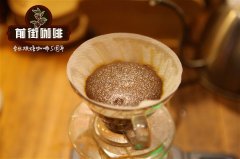Learn to make coffee questions and answer questions for beginners in hand brewing coffee

Professional coffee knowledge exchange more coffee bean information please follow the coffee workshop (Wechat official account cafe_style)
Hello everyone, friends will buy coffee utensils and coffee beans home to make their own coffee, editors often receive a variety of hand-made coffee problems, friends' enthusiasm for discussion is also very high. So today, the editor will come to share with you some common questions of newcomers.
This is the first question: do you find that you can't get into the water by injecting water into the coffee by hand? The editor tells you that this is the right operation!
The function of steaming is to let the hot water slowly seep into the center of the coffee powder so that the substance in the coffee powder dissolves in the hot water first to form a high concentration of coffee liquid. In the second brewing, using the physical phenomenon of the concentration, the high concentration (steamed coffee liquid) moves to the low concentration (hot water) and reaches the middle concentration (the concentration is the same).
So if there is too much steaming water, dripping a large amount of coffee liquid, the situation is that the falling water does not stay but directly brings out the substance outside the coffee powder. When the outer layer of coffee powder is dissolved, the inner layer of coffee powder is still dry. When hot water seeps into the inner layer of coffee powder.. The miscellaneous and astringent taste of the outer layer of coffee powder also began to dissolve. The coffee brewed in this way is not only light, but also has an exquisite mixed smell.
If the amount of stuffy steam is insufficient and no water droplets fall at all, then the coffee powder does not absorb enough water, and some coffee is not exhaust enough, which will cause insufficient extraction.
So how much steaming water should be used to make coffee by hand?
In general, there are two algorithms:
① is 1.5 times the amount of coffee powder. For example, using 15 grams of coffee powder, the amount of steaming water is about 23 grams and 30 grams, and the amount of light roasted coffee can be slightly less.
② to extract 1ml of total coffee 10, for example, to extract 240ml of coffee, steaming water with 240g, the same light roasted coffee can be slightly less
Therefore, in the correct steaming state, it is best to drop a few drops of water, but only if the steaming water is completely and evenly distributed on the coffee powder as shown above, to ensure that every coffee powder can absorb water.
The second question, first of all, where does the acid of coffee come from? Coffee is one of the plants with the highest content of chlorogenic acid in the plant kingdom, and chlorogenic acid is a strong antioxidant. In addition, coffee also contains formic acid (oxalic acid), citric acid, malic acid and other sour chemicals. In the treatment of raw beans, acetic acid (acetic acid) and lactic acid will be produced. In the final baking, although some acids will be decomposed by heat, generally speaking, citric acid, malic acid, lactic acid and acetic acid will be more retained. So coffee always has a sour taste ~ after all, coffee is a kind of fruit.
So even medium-to-deep roasted coffee, such as Blue Mountain and Manning, will still have a sour taste, but less sour compared to medium-and light-roasted coffee. In addition, the taste of coffee is a compound state, and the four flavors of sour, salty, bitter and sweet not only gain each other, but also suppress each other. For example, a certain sweetness can suppress sour taste, while a certain salty taste can highlight sweetness and so on. In addition, when we judge the acidity of coffee, in addition to acidity, we should also consider the acidity, that is, the quality of acid.
For example, the medium-deep baked Blue Mountain, we say that it is a very balanced coffee with low acidity, but it has a good acidity. What this sentence says is that Blue Mountain Coffee has a soft acid, and it is a high-quality acid, which makes people taste delicious.
For example, the bright berry acid and citric acid of Kenyan coffee, although the acidity is high, but the sour taste of good Kenyan coffee can be transformed into the sweet and sour taste of fruit, which is also excellent acidity.
But if it is low-quality acid, such as high acidity only makes people show teeth, or low acidity, but dull and inactive acid, it is not good acid quality.
The third question, how to master the water-powder ratio of hand-brewed coffee? To tell you the truth, the editor thinks that if you like coffee, some people like strong ones, others like light ones.
But what I want to say here is why do we always recommend gouache ratio between 1-14-14-1-1-16?
First of all, let's talk about the water-to-powder ratio we measured in the cup-- 1purl 18.8.
The purpose of this ratio is to keep the concentration and extraction rate of coffee within the range of gold cup, that is, 1. 5%. The extraction rate is between 18% and 22%. two。 The coffee concentration is in the range of 1.2% to 1.45%.
As for the water-powder ratio of hand-brewed coffee, it is to make your coffee taste better. Because friends who have done a cup test all know that the coffee tested in the cup is relatively light, this is in order to better distinguish the various flavors of the coffee, and the cup test round is about 20 minutes, the coffee powder is completely soaked, and the flavor can be completely released. On the other hand, hand brewing takes out the coffee contents with water within 2-3 minutes, so in order to achieve the same extraction effect, it is necessary to reduce the ratio of water to powder ~ 1, 14, 14, 1, 16 (depending on the roasting degree of coffee), and this ratio will not be too bad as long as there is no "divine operation" in the process of brewing.
Of course, there are exceptions to everything. The editor personally likes to brew the red standard rose summer in the jadeite manor at 1:18, which can show the complete aroma of flowers and fruit. You can also use 1:13 or even 1:12 to rush the Blue Mountains or Manning, that is, only extract the flavor of the front and middle section.
As for the various methods of making coffee by hand, the editor's suggestion is that as long as the coffee tastes good, it doesn't matter how it is made!
Today's last question, how long should Erica keep beans? Have read us: the front street teaches you to make coffee | the significance of fresh coffee-friends who raise beans will know it.
Erica this coffee belongs to shallow roasting, the exhaust of shallow roasted beans is relatively uniform and slow, so it takes longer to complete ripening, it is normal to keep it for 5-7 days, if you store it at a low ambient temperature, it is no problem to keep it for 8 or 10 days.
The above is only a small part of the novice question of hand-brewing coffee. If there are any mistakes and inadequacies, you are welcome to add to the discussion. If you have any other questions about coffee, you are welcome to communicate with us, and we will try our best to answer them.
Looking forward to the next issue of coffee novice Q & A! Let's work together to improve our professional level.
Related recommendation: is hand-made coffee really good? Why does coffee smell better than it tastes?
Important Notice :
前街咖啡 FrontStreet Coffee has moved to new addredd:
FrontStreet Coffee Address: 315,Donghua East Road,GuangZhou
Tel:020 38364473
- Prev

Water injection techniques and techniques for hand-brewed coffee explain how to inject water into hand-brewed coffee
Professional coffee knowledge exchange more coffee bean information Please pay attention to the coffee workshop (Wechat official account cafe_style) handmade coffee is probably the most common method of brewing it is one-size-fits-all and segmented extraction. The name "one knife flow" sounds very interesting, very much like a martial arts move in a martial arts novel. The secret meaning of this method of brewing coffee by hand is steaming.
- Next

Key points of steaming and water injection when making coffee by hand what should we pay attention to when making coffee by hand?
Professional coffee knowledge exchange more coffee bean information please follow the coffee workshop (Wechat official account cafe_style) in hand coffee, what is steaming? Why are you steaming? The microstructure of coffee powder is actually similar to that of a honeycomb, with numerous penetrating holes. Coffee beans will continue to emit carbon dioxide and volatile aromatic substances after roasting.
Related
- Beginners will see the "Coffee pull flower" guide!
- What is the difference between ice blog purified milk and ordinary milk coffee?
- Why is the Philippines the largest producer of crops in Liberia?
- For coffee extraction, should the fine powder be retained?
- How does extracted espresso fill pressed powder? How much strength does it take to press the powder?
- How to make jasmine cold extract coffee? Is the jasmine + latte good?
- Will this little toy really make the coffee taste better? How does Lily Drip affect coffee extraction?
- Will the action of slapping the filter cup also affect coffee extraction?
- What's the difference between powder-to-water ratio and powder-to-liquid ratio?
- What is the Ethiopian local species? What does it have to do with Heirloom native species?

